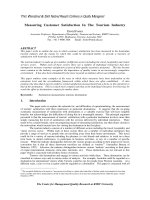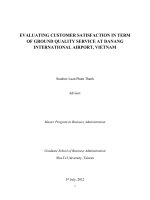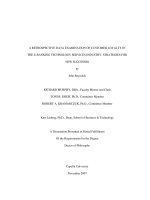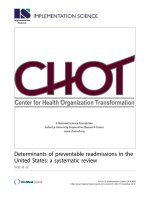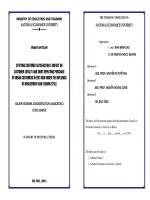Determinants of customer satisfaction in the apartment industry the cace for the apartment industry in vietnam
Bạn đang xem bản rút gọn của tài liệu. Xem và tải ngay bản đầy đủ của tài liệu tại đây (713.25 KB, 73 trang )
MINISTRY OF EDUCATION AND TRAINING
UNIVERSITY OF ECONOMICS HOCHIMINH CITY
NGUYEN THI MONG VAN
DETERMINANTS OF CUSTOMER SATISFACTION
IN THE APARTMENT INDUSTRY
THE CASE FOR THE APARTMENT INDUSTRY IN VIETNAM
MASTER’S THESIS
In
Business Administration
Ology code: 60.34.01.02
Supervisor
Dr. Tran Ha Minh Quan
Ho Chi Minh City, 2012
----------
1
Acknowledgement
This research project would not have been possible without the support of
many people. Firstly, I wish to express my deep sincere gratitude to my supervisor,
Dr. Tran Ha Minh Quan for his invaluable advice and help. Without him, this thesis
could not have been completed.
I would like to express my deepest gratitude and honor to my parents not
only for the love they devote to me but also for the time which I should have
devoted to them during their senior years.
I am also grateful to my classmates and my colleagues, especially Le Thi
Bich Dao and Ngo van Quan for all of their friendship and encouragement.
I also wish to thank my friends in Becamex subsidiaries for their great
support, and to the respondents, without whom, my thesis could not have been
accomplished.
Finally, I am most grateful to my dear husband. He is my whole life. He is
my greatest inspiration and the source of encouragement to overcome all difficulties
through out the duration of this study.
2
Abstract
In market economy, quality of products or services is the most important tool
to succeed. The nature of the quality of goods is intended to satisfy the needs of the
highest enjoyment of goods or services. Construction work in general
and of apartment buildings in particular are a type of goods. The criteria for the quality
of it also must be directed towards those values. However, the criteria for the
quality of goods or construction in general and apartment buildings in particular
is extremely diverse. The business activities in the field of real estate are trying to
improve the quality of products and services to satisfy the maximum demands of
customers, especially in the apartment business. This study examined the
determinants of satisfaction and the effects of customer satisfaction on word of
mouth of consumers in the apartment industry in Vietnam, as well as the influence
of background data on the relationship between satisfaction and word of mouth
activity. This research measures the factors influencing apartment satisfaction in
quantitative research methods. The scale was evaluated by the factor analysis
method to explore EFA and reliability testing (Cronbach's alpha) then multiple
regression analysis is used to test the research model.
This study will help to improve the strategies of real estate companies in
choosing the best measures to improve the quality of their company's product, while
increasing competitiveness and solidify the company's position in the marketplace.
As time was short, this study focused its review on the relationship between six
factors influencing their apartment construction and intention to engage in word of
mouth activity.
Keyword: Customer satisfaction, word of mouth, Service quality, apartment
industry.
3
Contents
Acknowledgement ................................................................................................... 1
Abstract.................................................................................................................... 2
Contents ................................................................................................................... 3
List of Tables ........................................................................................................... 6
List of Figures .......................................................................................................... 7
Chapter 1: INTRODUCTION ................................................................................ 8
1.1 Overview ........................................................................................................ 8
1.2 Research background ........................................................................................ 8
1.3 Problem statement............................................................................................. 9
1.4
Purpose of the study......................................................................................... 10
1.5
Objectives of the study..................................................................................... 10
1.6 Research question ............................................................................................. 11
1.7 Significance of the study ................................................................................... 11
1.8 Structure of thesis ............................................................................................. 11
Chapter 2: LITERATURE REVIEW .................................................................... 13
2.1 Overview ............................................................................................................. 13
2.2 Overall customer satisfaction............................................................................... 13
2.2.1 Concept of customer satisfaction ............................................................... 13
2.2.2 Determinants of customer satisfaction ....................................................... 14
2.3 Hypotheses and model ........................................................................................ 16
2.3.1 Customer cost ........................................................................................ 16
2.3.2 Physical quality...................................................................................... 17
2.3.3 Environmental quality............................................................................ 19
2.3.4 Project facilities ..................................................................................... 19
2.3.5 Regional facilities .................................................................................. 20
2.3.6 Service quality . ..................................................................................... 20
2.3.7 Relationship between customer satisfaction and word of mouth ............. 22
2.4 Conclusion........................................................................................................... 24
Chapter 3: RESEARCH METHODOLOGY......................................................... 25
4
3.1 Overview ............................................................................................................. 25
3.2. Research purpose................................................................................................ 25
3.3 Research design ................................................................................................... 26
3.4. Item generation................................................................................................... 26
3.4.1 Overall customer satisfaction scale......................................................... 26
3.4.2 Scale to measure service quality............................................................. 28
3.4.3 Scale to measure customer satisfaction................................................... 29
3.4.4 Scale to measure word of mouth ............................................................ 34
3.5 Pilot test............................................................................................................... 34
3.6 Main study........................................................................................................... 35
3.6.1 Sampling................................................................................................ 35
3.6.2 Sample size ............................................................................................ 36
3.6.3 Data analysis techniques ........................................................................ 36
3.7 Conclusion........................................................................................................... 37
Chapter 4: DATA ANLYSIS AND FINDINGS ..................................................... 38
4.1 Overview ............................................................................................................. 38
4.2 Respondents demographics.................................................................................. 38
4.3 Scale assessment.................................................................................................. 39
4.3.1 Reliability testing (Cronbach’s Alpha) ................................................... 40
4.3.2 Exploratory factor analysis..................................................................... 42
4.3.2.1 Exploratory factor analysis with determinants of customer
satisfaction ................................................................................................................ 42
4.3.2.2 Exploratory factor analysis with overall customer satisfaction
and word of mouth .................................................................................................... 45
4.4 Testing research model and hypotheses ............................................................... 45
4.4.1 Testing correlations between all constructs ............................................ 45
4.4.2 Testing research model and hypotheses.................................................. 46
4.4.2.1 The relationship between determinants of customer
satisfaction in the apartment industry and customer satisfaction...................... 46
4.4.2.2 The relationship between overall customer satisfaction and
word of mouth in the apartment industry......................................................... 49
4.5 Conclusion........................................................................................................... 50
5
Chapter 5: CONCLUSIONS AND IMPLICATIONS ....................................... 51
5.1 Overview ......................................................................................................... 51
5.2 Conclusions of the study.................................................................................. 51
5.3 Implications of the study.................................................................................. 51
5.3.1 Theoretical implications..................................................................... 51
5.3.2 Practical implications ......................................................................... 52
5.4 Limitations and recommendations for future research...................................... 52
List of References ................................................................................................ 54
Appendix 1- Questionnaire (Vietnamese version).............................................. 60
Appendix 2- Observed variables......................................................................... 63
Appendix 3 - Descriptive statistics of variables.................................................. 65
Appendix 4 - Reliability analysis- Cronbach’s Alpha ................................... 66
Appendix 5 - Factor analysis............................................................................... 69
Appendix 6 - Regression result ........................................................................... 71
6
List of Tables
Table 2.1 Service quality dimension definitions (modified from Zenithal et al.,
1990) ..................................................................................................................... 22
Table 3.1 Scale to measure service quality............................................................. 29
Table 3.2 Scale to measure customer cost ............................................................. 32
Table 3.3 Scale to measure physical quality........................................................... 32
Table 3.4 Scale to measure environmental quality ................................................. 32
Table 3.5 Scale to measure project facilities ......................................................... 33
Table 3.6 Scale to measure region facilities .......................................................... 33
Table 3.7 Scale to measure customer satisfaction ................................................. 33
Table 3.8 Scale to measure word of mouth ........................................................... 34
Table 4.1 Demographic profile of respondents ...................................................... 38
Table 4.2 Reliability of measurement items .......................................................... 41
Table 4.3 EFA result for construct measurement scales (2nd times) ...................... 43
Table 4.4 Total variance explained ........................................................................ 44
Table 4.5 EFA result for construct measurement scales ......................................... 45
Table 4.6 Correlation matrix.................................................................................. 46
Table 4.7a Model summary ................................................................................... 47
Table 4.7b ANOVAb............................................................................................. 47
Table 4.7c Coefficients.......................................................................................... 48
Table 4.8 Summary of hypotheses testing results................................................... 49
Table 4.9a Model II summary................................................................................ 50
Table 4.9b Coefficients.......................................................................................... 50
7
List of Figures
Figure 1.1 Structure of Thesis................................................................................ 12
Figure 2.1 Research model of customer satisfaction .............................................. 24
Figure 3.1 Research process .................................................................................. 27
Figure 3.2 Response rate........................................................................................ 36
Figure 4.1 Means of joining of respondents ........................................................... 39
Figure 4.2 Relationship between determinants of customer satisfaction in apartment
industry and customer satisfaction. ........................................................................ 47
Figure 4.3 Relationship between overall customer satisfaction and word of mouth in
apartment industry................................................................................................. 49
8
Chapter 1: INTRODUCTION
1.1 Overview
This chapter presents an overview of the research, the Background to the study,
Problem statement, purpose of the study, objectives of the study, research questions,
significance of the study, and structure of thesis
1.2 Background to the study
Customer satisfaction is one of the key issues for companies in their efforts to
improve quality in the market place. Most businesses have their own targets for
being profitable. They have carefully planned and implemented strategies, but they
all have something in common – a customer. Business purposes are based on
customers and if the company wants to be successful, it has to concentrate on them.
This means determining customers’ needs, responding to their requirements and
maintaining customer satisfaction by assuring quality in company’s operations.
Besides, customer satisfaction is so important, because satisfied customers spread
positive word of mouth which attracts more new customers, and then companies
will sell more and gain high profits (Garson 1993, 5.)
The apartment industry in Vietnam recently formed and flourished in recent years.
The development of the apartment industry has contributed greatly to the
urbanization of Vietnam. Currently, however, the apartment market in Vietnam has
fallen in the general downturn of the economy. Project investors such as Hoang Anh
Gia Lai are decreasing their prices in a number of new apartment projects as much
as 40%. Other projects such as the Discovery Complex apartment project in Hanoi,
Dai Thanh project, etc. are experiencing a similar depreciation.
Competition between investors is fierce among apartment products as well as other
commodities in the market. Therefore, when consumers decide to buy or invest
property goods, customers will consider many factors that affect their decision to
buy and satisfy their life needs. Apartment investors must understand these factors
to build an effective business strategy.
VNR survey data of property report (2009-2010) indicates that, the most important
9
factor for customer satisfaction is the location of the project (gaining an advantage
position of 71.2%). Next is the project design factor. In addition to these factors, the
decision to buy is based on the flow of information relating to apartment options
before buying. This is where word of mouth has a large influence. In order to
increase sales, investors need to understand the factors affecting customer
satisfaction and enhance positive communication activities to develop more new
customers.
1.3 Problem Statement
The Vietnamese economy is developing in accordance with Party economic policy.
The population’s incomes was increased dramatically, demand for housing along
with a growing. Current, source of housing supply from many Vietnam and foreign
real estate companies are quite diverse.
When Vietnam integrated into the world economy, conceptions about the apartment
industry gradually changed along with the developing of the economy. Today,
owning an apartment is proud choice, especially for young people because interior
decorations of apartments that are modern, luxurious and similar to 4 or 5 star
hotels. Each apartment is designed close to public services, such as supermarkets,
Asian and European restaurants, swimming pool, multi gym, postal services,
banking, kindergarten, office of the company, etc. as a miniature city, so that people
can use the utility on the spot without having to go far, etc.
In order to meet this demand, many construction companies have invested in this
sector. Compared to just two years ago, this year the apartment industry has
diversified profusely.
Due to the increased competition experienced between firms, customer satisfaction
has become more important. Good product and quality differentiates between
products, ensures consumer loyalty and may lead to increased market share.
In Vietnam, empirical studies on the state of customer satisfaction in the apartment
industry are very scant. The increase competition in the apartment industry in
Vietnam and the growth trend in real estate supply for the past decade, does not
10
provide empirical support for the claim that customer are satisfied with the quality
delivered by firms in the industry. It is necessary to increase understanding of the
factors that drive customer satisfaction in this industry in order to provide
management with empirical basis for developing effective marketing strategies.
1.4 Purpose of the study
Currently, customers spend a large amount of money to buy an apartment but the
build quality and services provided are very low. In some apartment projects, after
two years from purchase date, the walls are cracked, sanitary ware is rusted , etc.
despite, in the purchase apartments contract have recorded in detail of interior
construction materials and structural apartment, when building investors have
arbitrarily changed without notice to customers. A series of accompanying utility
services such as entertainment place, parking, etc. that investors introduced to
customers when signing purchase contracts that are not included in the utility of
building.
It is very necessary to research the service or product quality because of affecting
customer satisfaction, creating belief in investing and residing in apartment.
For the above identified research problem, the main purpose of this study is to
analyze the factors related to overall customer satisfaction and intention to engage
in word of mouth activity in apartment industry in Vietnam.
1.5 Objectives of the study
The following are the specific objectives of this study:
- To examine the determinants of customer satisfaction in the apartment
industry in Vietnam.
- To identify the relationship between customer satisfaction and word of
mouth communication.
1.6 Research question
1. What are the determinants of customer satisfaction in apartment industry in
Vietnam?
2. Is there relationship between the customer satisfaction and word of mouth
11
communication in the apartment industry in Vietnam?
1.7 Significance of the study
This study is significant in evaluating customer satisfaction in the apartment
industry:
First, it will provide the basis for making decisions about improvements in current
housing stock as well as the design and development of future housing.
Second, it will encourage housing managers, designers, and policy makers to be
more accountable.
Third, to policy makers the finds and results of this study will provide insights and
guidance to help monitor the operations of the apartment industry in Vietnam.
Forth, will show the impact on physical and psychological health of customers who
reside in apartments.
1.8 Structure of Thesis
The study is organized into five chapters (Figure 1.1).
Figure 1.1 Structure of Thesis
METHODOLOGY
LITERATURE
REVIEW
INTRODUCTION
DATA ANALYSIS
& DISCUSSION
CONCLUSION
Chapter one is the introductory chapter. It includes the background, problem
statement, purpose of the study, objectives, research questions, significance, and
structure of thesis.
Chapter two reviews relevant literature, concepts and theoretical framework: overall
customer satisfaction, factors influence on customer satisfaction, research model,
12
hypothesis and chapter summary.
Chapter three provides the methodology of this section. It focuses on the research
perspectives, data collection. It identifies the hypotheses and explains in detail the
main constructs and concepts as well as their indicators and measurements.
Chapter four presents the data analysis and resulting and findings.
Chapter five presents the conclusions and implications.
13
CHAPTER 2: LITERATURE REVIEW
2.1 Overview
The previous chapter introduces an overview of the study background, the research
of objective and the research questions. This chapter provides a detail review of
relevant literature. This chapter covers brief concept and theoretical framework:
overall customer satisfaction, determinants of customer satisfaction, research
model, hypothesis and chapter summary.
2.2 Overall customer satisfaction
2.2.1 Concept of customer satisfaction
Customer satisfaction is a key element in the business strategies and goals of all
businesses in today’s competitive market (Gro’nroos, 1984; Lovelock & Wirtz,
2007; Anderson, Fornell, and Lehman, 1994). There are many concepts of customer
satisfaction defined by many authors. ‘‘Satisfaction is a person’s feeling of pleasure
or disappointment resulting from comparing a product’s performance (outcome) in
relation to his or her expectation’’ (Kotler & Keller, 2006 p. 144). Satisfaction is a
‘‘psychological concept that involves the feeling of well-being and pleasure that
results from obtaining what one hopes for and expects from an appealing product
and/or service’’ (WTO, 1985). Customer satisfaction is “as an attitude-like
adjustment following a purchase act or a series of consumer product interactions”
Youjae Yi (1990 cited in Lovelock & Wirtz 2007). Customer satisfaction is ‘‘a
consumer’s post-purchase evaluation and affective response to the overall product
or service experience’’ (Oliver, 1992). ‘‘Satisfaction is merely the result of things
not going wrong; satisfying the needs and desires of consumers.’’(Besterfield
1994); According to Gyasi and Azumah (2009) satisfaction is “The process of
customer overall subjective evaluation of the product/service quality against his/her
expectation or desires over a time period.”
Admittedly, satisfaction is more complicated to define to accurately fit every
context and measure. In the words of Oliver (1997), “everyone knows what
14
[satisfaction] is until asked to give a definition. Then it seems, nobody knows”.
From marketing perspectives, customer satisfaction has multi-dimensionality. The
object of customer satisfaction may be varied and can be related to different
dimensions of multiple experiences with product/service provider (Surenshchandar
et al. 2002 cited in Satari, 2007). Besides, the product or service quality there can be
several dimensions (Gro¨nroos, 2000, 2001; Edvardsson, 2005), such as what the
product offers, product or service reliability, timeliness, friendliness of the service
providers, and the like. Therefore, depending on the purpose one wants to achieve,
one can relate satisfaction to any object of interest.
Hence, there are a lot of definitions of customer satisfaction as well as a lot of
controversies about it. Providing a precise definition of satisfaction is difficult.
However, we can understand customer satisfaction as follow: "This is the response
of consumers to meeting consumer’s needs" (Oliver 1997, 13). This definition
implies that satisfaction is consumers’ satisfaction in the consumption of products
or services because that meet their expectations, including the level of satisfaction
on both the desired level, equal to the desired level and also less than the desired
level. Thus, in order to meet the research objectives, the definition of customer
satisfaction in apartment industry is defined as follows:
- The expectations of customers resident in apartments compared with reality
of their experience.
- Benefits received when living in that apartment.
2.2.2 Determinants of customer satisfaction.
Many factors drive customer satisfaction that need to be examined in order to
reliably measure it. Satisfaction is an overall customer attitude towards products, or
an emotional reaction to the difference between what customers anticipate and what
they receive, regarding the fulfillment of some need, goal or desire (Hansemark and
Albinsson, 2004). Satisfaction is a person’s feeling of pleasure or disappointment
resulting from comparing his/her expectation of a given experience with the product
or service. If performance fails to meet expectations, the customer will be
15
dissatisfied. If the performance matches the expectations, the customer is satisfied.
If the performance exceeds expectations, the customer is highly delighted (Kotler
and Keller, 2006).
In the apartment industry, determinants of customer satisfaction have not to date
been well researched. Sale (2008) observed that building features, such as number
of bedrooms, size and location of kitchen, quality of housing units were strongly
related to customer satisfaction. Also satisfaction with neighborhood facilities such
as schools, health care, shopping and community social centre has been noted to be
an important factor of customer satisfaction. The research of Djebarni and Albed
(2000) assessed and compared residents’ satisfaction with their housing and
environment in the three housing schemes in Yemen. They gave variables in model
of housing satisfaction measurability are housing environment (the dwelling unit,
neighborhood and community services) and housing quality (dwelling interior
schedule, dwelling exterior schedule, and dwelling environment schedule). In the
interview, residents showed that the level of satisfaction with their neighborhoods is
the most important issue. The most important factor combined with neighborhood
satisfaction was privacy, a reflection of the cultural background in Yemeni society.
Oh (2000) in her study on housing satisfaction in Bandar Bare Bang, Malaysia,
revealed that while the residents were satisfied with the space and cost of house
owned, they were dissatisfied with the size of the kitchen, plumbing, and public
facilities such as recreational areas, playground, taxis and bus services in the area.
The research of Tsembelis et al. (2003) indicated that housing satisfaction was
influenced by the surrounding neighborhood, patterns of social interaction,
satisfaction with the management practice of repair, tenant involvement, besides the
quality of home itself.
The study of Phillips et al. (2005) examined the role of residential satisfaction
(satisfaction with dwelling unit, estate, and district) in mediating the effects of
dwelling conditions (interior environment and exterior environment) on
16
psychological well-being. He provided dwelling conditions factors that affect on
older residents satisfaction and psychological well-being.
The study of Tu and Lin (2008) identified the internal evaluative structure with
which Taipei City's residents assessed the quality of their residential environment in
high-density and mixed-use settings. In the study, The principal component analysis
result reveals a multidimensional evaluative structure of residential environment
quality perceived by Taipei City's residents, which consists of six evaluation scales
(i.e. urban planning and design, security and social relationship, transportation and
commercial services, residential atmosphere, environmental health, and facility
management) with eleven underlying factors.
Amole (2009) investigated the characteristics of residence halls in Nigeria that
correspond with high levels of residential satisfaction among students. His study
indicated that the variables which explained satisfaction were the social qualities of
the residences (especially, the social densities) the kitchenette, bathroom, and
storage facilities and some demographic characteristics of the students.
In 2009 Nahmens and Ikuma surveyed customer satisfaction with service quality,
and assessed the correlations between various factors on home buyer expectations
and their perceptions of service quality.
The study of Yau et al. (2009) used the Building Quality Index (BQI) developed by
The University of Hong Kong to indicate determinants of building performance.
Those are architecture, building services, operations and maintenance, external
environment, and management approaches.
Based on the above review of the literature, in this study will examine customers’
satisfaction through the following determinants are customer cost, physical quality,
environmental quality, service quality, project facilities, and region facilities.
2.3 Hypotheses and model
2.3.1 Customer cost
Customer cost refers to the price of a product and includes the purchase costs, use
costs and post-use costs that customers must absorb to own the product. In this
17
study, customer cost relates to the expense of initial purchase as well as the expense
of subsequent maintenance.
Price is seen as consumer awareness of abandonment or sacrifice of something in
order to own a product or a service (Zenithal, 1988). Price of the product or service
can be greatly influenced by the perception of product quality, service, satisfaction
and value. Some Researchers have found that there is a significant relationship
between price and satisfaction customers (Varki and Colgate, 2001). They showed
that after buying a product, the perceived price positive impact on customer
satisfaction.
In the apartment industry, customer cost plays an important role in conveying
customer satisfaction. In which, price and support credit is one of the important
factors. Based on the above literature, the first hypothesis between feeling about
customer cost and the level of customer satisfaction covariant relations, as specific:
H1: Customer cost has a significant positive direct effect on overall customer
satisfaction.
2.3.2 Physical quality
Quality of housing is a combination both of user requirements and user satisfaction.
The main source of many problems occurs as a result of health, safety and physical
problems caused by the condition of the apartment. The quality of the walls, quality
the floors, windows, doors and paint are all indicators of the apartment (Ukoha and
Beamish 1997, Salleh, et al 2011).
In apartments, the quality of the walls is important. Major cracks result in major
repairs. The materials use for the walls also affect building temperature. While,
materials of floor in apartment are fully cemented, residents can use other materials
based on their preference.
Besides that, quality windows provide good ventilation and air circulation. If
windows are unable the temperature in apartment will rise, and residents will feel
uncomfortable. This also can affect mental health, especially for children and
elders.
18
Besides, in order to distinguish an apartment were in a good quality or not were
based on the architecture from internal and external aspects and also the nearby area
(Sale 2011). Internal architectural features include the dwelling size (Turkoglu1997,
Chi and Ann 1979, Liu 1999), the size of the living room, bedroom, the kitchen,
toilets and washing area (Sale et al 2011, Poke, Abdul-Mushin 2010), the number of
bedroom (Ibex and Amole 2010, Nurhayatii Sebli, Bujang Ahmad Ariffian 2008
and Ilesanmi 2010), the location of the bedroom and the size of the dining room
(Ukoha and Beamish (1997) laundry and washing area (Mohit et al 2010).
The combination of size of living room, bedroom, dining room, toilets and
bathroom, kitchens are the main issues studied by various scholars since 1980s.
Number and location of bedroom, kitchen, commode, laundry, and washing area
must be considered carefully to construct quality apartments.
Lighting is also a basic need. It was rated a priority concern for users after health
and safety. Lightings is really emphasized in new construction. It influences mental
health, while the lack of it will contribute to mental disorder (Ibem and Amole
2011). Lighting indicators consists of the following:
a) Natural lighting (Djebarni and Abed 1998, Liu 1999, Calvert 2009, Ibem and
Amole 2011, Pacione 1984, Ilesanmi 2010, Savasdisara et al 1989, JianGe,
Kazunori Hokao 2006)
b) Artificial lighting (Djebarni and Abed 1998, Chi and Ann 1979).
c) Quality of lighting (Kincaid 1994).
Natural lighting is adequacy of daylight distribution within the apartment. Artificial
lighting is powered by electrical energy such as the lamp. Nowadays, artificial
lightings is found everywhere in an apartments in the living room, bedrooms, toilets
and in all public areas of the building. Both natural lighting and artificial lighting
affect the quality of lighting in the apartment. It cause physical and mental (Jeong
and Lee 2006).
Besides, the basic requirement in apartment such as water pressure, sewerage is a
fundamental of the quality of apartment that can affect human psychology, social
19
and economic (Nurhayatii Sebli, Bujang Ahmad Ariffian 2008). Similarly, to
drainage, it is important to avoid any health problem and cleanliness problem. It
will take care by the apartment management. Therefore, the physical quality has a
contribution on customer needs. The second hypothesis is proposed as follows:
H2: Physical quality has a significant positive direct effect on overall customer
satisfaction.
2.3.3 Environmental quality
When buying apartment, it is important to assess the environmental quality of the
building because it affect the resident’s health and safety.
The high inhabitant density in apartment building will generate a lot of noise either
from the neighborhood or traffic, and it is difficult to reduce the noise level. Parkers
et al (2002) indicated that, noise from a neighbor shows the general appearance of
neighborhood somehow it will give problems and enormous effect to the
relationship between neighbors, and causing social problem and lack of safety.
Noise from traffic and outdoor, for instance, street fighting or violence, that will
make inhabitants unsafe. Noise categorized as domestic disturbance influences
mental health (Andersen 2008). Security is also an important concern. Apartment
buildings must be equipped with a security camera system.
The apartment is not only a place to live but also a place to rest, relax and
communicate with the community. So, environmental quality should be noted.
Consequently, the third hypothesis is proposed as follows:
H3: Environmental quality has a significant positive direct effect on overall
customer satisfaction.
2.3.4 Project facilities
In general, project facilities are necessary to enhance resident's daily activities.
Moreover, most daily activities occur in the apartment building, so the basic utilities
are the necessity in designing apartment. Utilities and services elements are parking
place, lobby, ladder, lift, etc.
In apartment building, ladder and lift are necessary. They are essential for access.
20
Storage space in apartments is connected with apartment satisfaction. Most of the
apartments lack adequate storage space. Parking is also a vital contribution to
customer satisfaction. From above problem, the forth hypothesis is proposed as
follows:
H4: Project facilities have a significant positive direct effect on overall customer
satisfaction.
2.3.5 Region facilities
In the apartment industry, region facilities factor is related to location. According to
Nicola (2003) appropriate location and accessibility of to service delivery and
infrastructure are the key attributes to make the house adequate and meet the
inhabitants’ needs. Convenience of location will give benefits to owners as well as
users because it will be easy for them to do their daily activities conveniently. It
also will contribute to better living condition. Mohit et al (2010), Kellekci & Berkoz
(2009), Pushpa and Rosadah (2008) state that location choice near to the town
centre genuinely influences user preference. Turkoglu (1997) and Kellekci &
Berkoz (2009) found that accessibility to educational institutions such as primary
and secondary school, for instance, clinics and hospitals are crucial indicators that
influences user preference. Mohit et al (2010), Calvert (2009), Ibem and Amole
(2011) assert that proximity to recreational parks is listed as quality in housing.
Users can spend their time relaxing and chatting with neighbors there.
Mohit et al (2010), Salleh (2011) and Kellekci & Berkoz (2009) ascertained that
users prefer strategic locations near shopping centers and markets or shops because
they can go shopping easily by walking. So, it is important to assess region facilities
that influence the residents' preference as well as to enhance the quality of the
apartment. From above problem, the fifth hypothesis is proposed as follows:
H5: Region facilities have a significant positive direct effect on overall customer
satisfaction.
2.3.6 Service quality.
Satisfaction also depends on product and service quality. Kotler and Keller (2006)
21
stated that quality is the totality of features and characteristics of a product or
service related to satisfying implied needs.
For decades, many researchers have developed a service perspective (Zeithaml,
2009, Ramsaran and Fowdar, 2007). Chang (2008) notes that the concept of service
quality should be generally approached from perspective of the customers because
they may have different values, different ground of assessment, and different
circumstances. Parasuraman, Zeithaml and Berry (1990) says that service quality is
an extrinsically perceived attribution based on the customers’ experience of the
service encounter. Especially, Lu and Sock, 2008 showed that improved service
quality will help companies ensure greater customer satisfaction. If a company
provides superior service, it will increase profitability and encourages positive
word of mouth recommendations to potential customers (He stein and Gamier,
2006).
In this study, the service quality assessment base on the model of Zenithal et
al. that model consists of five components with five characteristic (Table 2.1) as:
Appearance, Reliability, Timeliness, Knowledge and Empathy. Although, service
quality and satisfaction are two different concepts, they are closely related to each
other. The previous study has shown that service quality is the cause of satisfaction
(Cronin and Taylor, 1992) because quality relate to service delivery, satisfaction
only to be assessed after using that service. However, service quality are improved
good but not based on customer needs, consumer has never been satisfied with that
service. Therefore, quality is must ultimately be evaluated from the customer’s
perception. The sixth hypothesis is proposed as follows:
H6: Service quality has a significant positive direct effect on overall customer
satisfaction.
22
Table 2.1 Service quality dimension definitions (modified from Zeithaml et al.,
1990)
Service quality
dimension
Appearance
Reliability
Timeliness
Knowledge
Empathy
Original definition
Tailored definition for
home building
Visual impression of the service Visual impression of the
organization: facilities,
home builder: nice
equipment, and personnel.
brochures, Well decorated
sales office, sales personnel,
etc.
Consistency of performance and Consistency of performance
dependability
and dependability of the
service before, during and
after the home-buying
process.
Timeliness of service
Timeliness of the service
before, during and after the
Home buying process.
Possession of the required skills Appropriate knowledge and
and knowledge to perform the
skills required to perform
service. Ability to inspire trust
the service before, during
and confidence.
and after the home-buying
process.
Politeness, respect and
Politeness, respect and
friendliness of contact
friendliness of the sales
personnel. Individualized
personnel or any other
attention – making the effort to builder’s employee that
know customers and their
directly interacts with the
needs.
home buyers.
2.3.7 Relationship between customer satisfaction and word of mouth
Word of mouth has an important influence on the consumers’ behavior and sales
growth because through word of mouth, the company can get more customers faster
than by advertising and direct mail (Procter and Richards, 2002).
Especially,
information received through word of mouth is reliable because consumers have
recognized product characteristic with previous purchasing experiences. Consumers
have been found to rely on word of mouth to reduce the level of perceived risk and
the uncertainty that are often associated with service purchase decisions (Murray,
1991). Compared to purchasers of goods, Murray (1991) found that service
purchasers have greater confidence in personal sources of information as well as a
greater repurchase preference for personal information sources.
23
In approach to satisfaction as a post-choice evaluative judgment regarding a specific
purchase selection, satisfaction is understood by its transaction specific component
(Oliver 1981). Another approach sees satisfaction as the customers’ evaluations of
multiple experiences with the same product or service provider over time (Bolton
and Drew 1991), given that this cumulative construct incorporates previous
experiences and the cumulative satisfaction construct will contain an element of
customer attitude (Westbrook and Oliver 1991). Subsequent studies, however, have
demonstrated that, in addition to the cognitive view, customer satisfaction also
contains emotional components (Oliver and Westbrook 1993). A recent study
(Martin et al. 2008) agrees with Zeelenberg and Pieters (2004) in suggesting that
emotionally based satisfaction is a stronger predictor of future behavioral intentions
than traditional cognitive measures. The level of customer satisfaction has an effect
on two purchase behaviors, namely, repurchase intentions and word of mouth
(Oliver 1980). The likelihood of customers distributing word of mouth will depend
on their satisfaction level for at least two reasons. First, the extent to which the
product or service performance exceeds the customer’s expectations might motivate
him or her to tell others about his or her positive experience. Secondly, to the extent
that the customer’s expectations are not fulfilled, possibly creating a customer
regret experience and this customer will engage in word of mouth behavior as a
form of “venting” his or her negative emotions, such as anger and frustration,
warning others, and/or seeking retaliation (Oliver 1997) Indeed, there are a lot of
studies supporting for the significant effect of satisfaction on word of mouth
(Brown et al. 2005, Swan and Oliver 1989). Thus, based on the above definitions
and suggested relationships in the literature, the following hypothesis is formulated:
H7. Overall customer satisfaction has a significant positive direct effect on word of
mouth.
Basing on the above literature review and research question, to test the model of
customer satisfaction and intention to engage in word of mouth activity. This
research uses customer satisfaction model developed by Zadkarim S and Emari H
24
(2011) because this model describes the basic components of customer satisfaction
in apartment industry ( Figure 2.3). The researcher also assumes that there should be
some adjustments of the measurement scale in order to make the research model
more suitable for the apartment industry in Vietnam.
Figure 2.1
: Research model of customer satisfaction
Region
Facilities
Customer cost
H1
H5
H2
Physical quality
H3
Environmental
quality
Overall Customer
Satisfaction
H4
Project
Facilities
H7
Word of Mouth
H6
Service quality
The theoretical studies show that customer satisfaction in the apartment industry
depends on customer cost, physical quality, environmental quality, project facilities,
region facilities and service quality. Service quality item is an important item
proposed in the research model.
2.4 Conclusion
This chapter has examine theoretical framework of customer satisfaction. Six
factors - customer cost, physical quality, environmental quality, project facilities,
region facilities and service quality - are considered to influence customer
satisfaction and intention to engage in word of mouth activity. On that basis, a
customer satisfaction model with seven research hypotheses has been proposed. The
next chapter will present the research methodology.

